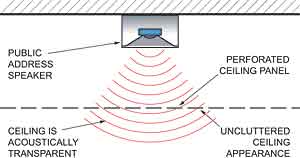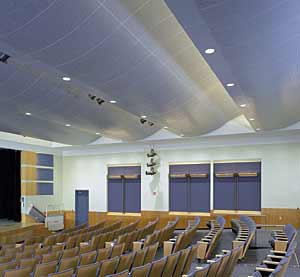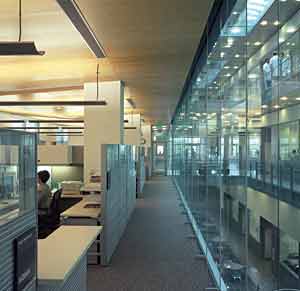Acoustical Reflectors: In many
rooms, it is useful to have ceilings that absorb noise in
certain areas while reflecting or reinforcing sound in other
areas. In a conference room, for example, the ceiling over
a conference table should be reflective to help a speaker's
voice project across the table, while the perimeter of a room
should be absorptive to reduce potentially distracting noise.
In addition, reflective ceilings are often required in auditoria
where it is necessary to project sound from a stage to the
back of an audience.

Public address
speakers, fire alarm enunciators, and other
acoustical systems can be located above the
acoustically transparent perforated ceiling
for increased security and reduced clutter. |
|
|
Sound reflects off smooth flat surfaces in the same way that
light strikes a mirror; the angle of reflection is equal to
the angle of incidence. In concert halls, convex shapes are
often desired to help scatter sound and prevent acoustical
hot spots; curved and faceted metal ceiling panels can be
employed for this purpose.
When a concave ceiling is required, the designer must consider
whether it will focus the sound in undesirable ways; if so,
perforated ceiling panels can be used to reduce acoustical
reflections.

Photo: Ceilings
Plus
In the Linder Theater at the American Museum
of Natural History in New York City, unperforated
metal ceiling panels were used help reflect
sound to the back of the hall. The panels'
curves helped to scatter the sound for a more
uniform quality throughout the room. Kupiec
Koustsomitis Architects was the designer. |
|
|
THE NEXT NEW THING
The past decade has been a time of rapid evolution in ceiling
designs. This trend appears to be continuing unabated into
the foreseeable future. Evidence of this is a recently introduced
extensible ceiling system that ships in a nested configuration
but slides open in the field to match the width of a room
or corridor.
|

Photo: Timothy
Hursley
The "collaboration zone" in the
Biodesign Institute at Arizona State
University was
designed to foster dialog among scientists
and research associates. Hard, acoustically
reflective finishes such as glass and terrazzo
made it necessary to use a NRC .95 ceiling
to facilitate speechcommunications. Gould
Evans, the project's primary architect,
used a perforated wood ceiling to control
noise and provide visual warmth. The fully
accessible ceiling simplifies maintenance
and reconfiguration of cables, pipes, and
other utilities serving laboratories. The
sameceiling is being used in Phase II, under
construction, in an effort to qualify for
LEED certification.
|
|
|
Architects continue to explore more complex geometries for
ceilings. Polygonal panels can be combined into exciting tessellation patterns. Scientists are experimenting with ways to eke greater
performance from acoustical materials. Product designers continue
their search for more aesthetic opportunities. And the criteria
for sustainable construction will undoubtedly become more
stringent. Clearly, there is no ceiling on the innovations
yet to come.
Author Bio:
Michael Chusid, RA, FCSI is an architectural consultant to
Ceilings Plus. His firm, Chusid Associates, specializes in
developing and marketing innovative building products.
|

|
|
Ceilings Plus (www.ceilingsplus.com)
is the leading specialty ceilings producer. Using
computer-assisted design and manufacturing, the
company fabricates ceilings and walls that are
architectural, functional, and affordable. Products
include curved Radiansâ„¢ and extensible Runwaysâ„¢
panels, plus Arboreal® panels with wood veneers
on aluminum cores. Panels can be almost any size
or shape and perforated to enhance appearance
and acoustics.
For sustainability, Ceilings Plus panels can
have recycled content as high as 85%. Arboreal
veneers can be FSC-Certified. Panels have no-added formaldehyde and
zero VOCs. Ceilings Plus products are durable,
easy to maintain, accessible and offer outstanding
life-cycle value. |
|












